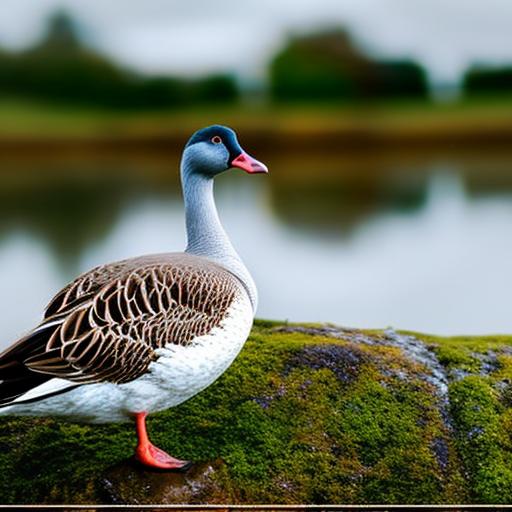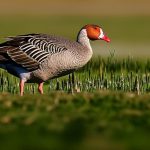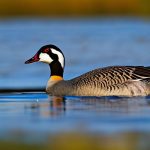West of England Geese, also known as Westies, are a breed of domestic geese that originated in the West Country of England. They have a long and storied history, dating back to the 18th century when they were first bred for their meat and feathers. Over the years, they have become popular among farmers and hobbyists alike for their unique characteristics and versatility.
The breed was developed by crossing the Chinese Goose with the Toulouse Goose, resulting in a bird that is known for its distinctive appearance and gentle temperament. West of England Geese are medium-sized birds, with males weighing between 12-14 pounds and females weighing between 10-12 pounds. They have a compact body shape, with a short neck and a broad chest. Their feathers are white and fluffy, with a soft texture that makes them highly prized for down production.
One of the main reasons why West of England Geese are popular among farmers and hobbyists is their excellent meat quality. The breed is known for its tender and flavorful meat, which is highly sought after by chefs and consumers alike. In addition to their meat, Westies also produce large eggs that are perfect for baking and cooking. Their eggs have a rich flavor and a high yolk-to-white ratio, making them ideal for making custards, pastries, and other delicious treats.
Key Takeaways
- West of England Geese are a heritage breed known for their unique appearance and friendly personalities.
- These geese are hardy and adaptable, making them a great choice for small-scale farming or backyard flocks.
- Providing a suitable habitat and proper nutrition is essential for the health and well-being of West of England Geese.
- Regular health checks and disease management are important to prevent illness and maintain a healthy flock.
- Breeding and selling West of England Geese can be a rewarding experience for those interested in preserving this rare breed.
Understanding the Characteristics of West of England Geese
When it comes to physical appearance, West of England Geese are easily recognizable. They have a compact body shape, with a short neck and a broad chest. Their feathers are white and fluffy, with a soft texture that makes them highly prized for down production. The breed also has a distinctive knob on its forehead, which is more pronounced in males than in females.
In terms of temperament and behavior, Westies are known for being docile and friendly. They are generally calm and easy to handle, making them a great choice for beginners or families with children. However, they can be protective of their territory and may become aggressive towards other animals or strangers if they feel threatened.
When it comes to egg-laying capacity, West of England Geese are known for being prolific layers. They can lay up to 40-50 eggs per year, with each egg weighing around 150-200 grams. The eggs have a rich flavor and a high yolk-to-white ratio, making them ideal for baking and cooking. However, it’s important to note that Westies are not as productive as some other breeds, such as the Embden or the Toulouse.
The Importance of Keeping West of England Geese
There are several benefits to keeping West of England Geese, both for farmers and homesteaders. For farmers, the breed offers a profitable opportunity to raise high-quality meat and feathers. The meat of Westies is known for its tender and flavorful taste, making it highly sought after by chefs and consumers alike. Additionally, their feathers are soft and fluffy, making them ideal for down production.
For homesteaders, West of England Geese provide a sustainable source of food and income. They are relatively easy to care for and require minimal inputs compared to other livestock. They can graze on pasture and forage for food, reducing the need for expensive feed. Additionally, their eggs can be used for baking and cooking, providing a nutritious source of protein.
In recent years, there has been a growing interest in conserving rare and heritage breeds of livestock, including West of England Geese. These breeds are often at risk of extinction due to the rise of commercial farming practices and the loss of traditional farming methods. By raising Westies, farmers and homesteaders can contribute to the preservation of this unique breed and help maintain genetic diversity in the poultry industry.
Creating a Suitable Habitat for West of England Geese
When it comes to housing requirements, West of England Geese are relatively low-maintenance. They can be housed in a simple shelter, such as a shed or a coop, as long as it provides protection from the elements and predators. The shelter should be well-ventilated and have enough space for the geese to move around comfortably.
In addition to a shelter, Westies also require access to outdoor space for grazing and exercise. They are natural grazers and enjoy foraging for food in grassy areas. Ideally, they should have access to a fenced-in pasture or a large yard where they can roam freely. It’s important to provide them with plenty of fresh grass and vegetation to eat, as well as access to clean water for drinking and bathing.
Speaking of water, West of England Geese have a strong affinity for water and should have access to a pond or a shallow pool for swimming. They enjoy splashing around and bathing in water, which helps keep their feathers clean and healthy. If you don’t have a natural water source on your property, you can provide them with a kiddie pool or a large tub filled with water.
Feeding West of England Geese
When it comes to feeding West of England Geese, it’s important to provide them with a balanced diet that meets their nutritional needs. They are natural grazers and enjoy foraging for food in grassy areas, so it’s important to provide them with plenty of fresh grass and vegetation to eat. In addition to grazing, they should also be fed a commercial poultry feed that is specifically formulated for geese.
The nutritional requirements of Westies vary depending on their age and stage of production. Growing goslings require a higher protein content in their diet to support their rapid growth, while adult geese require a lower protein content to maintain their body weight. It’s important to choose a feed that is appropriate for their age and stage of production.
In addition to their regular feed, West of England Geese may also benefit from supplements such as grit and oyster shell. Grit helps them digest their food by grinding it in their gizzard, while oyster shell provides them with calcium for strong eggshells. These supplements can be offered free-choice in a separate container.
When it comes to feeding and watering, it’s important to provide Westies with fresh food and water on a daily basis. Their water should be clean and free from contaminants, as dirty water can lead to health problems. It’s also a good idea to provide them with multiple water sources, especially during hot weather, to ensure they stay hydrated.
Health and Disease Management for West of England Geese

Like any livestock, West of England Geese are susceptible to certain health issues and diseases. It’s important to be aware of the common health issues that can affect them and take preventative measures to keep them healthy.
One common health issue that can affect Westies is bumblefoot, which is an infection of the foot caused by bacteria. It can be caused by walking on rough or dirty surfaces, so it’s important to provide them with clean and dry bedding in their shelter. Regularly inspecting their feet for any signs of swelling or redness can help catch the infection early and prevent it from spreading.
Another common health issue that can affect West of England Geese is respiratory infections, which are often caused by poor ventilation or overcrowding. It’s important to provide them with a well-ventilated shelter and avoid overcrowding them. Keeping their environment clean and dry can also help prevent the spread of respiratory infections.
In terms of preventative measures, it’s important to practice good biosecurity on your farm or homestead. This includes keeping your geese separate from other poultry species, disinfecting equipment and tools, and limiting access to your property. It’s also a good idea to work with a veterinarian who specializes in poultry health to develop a vaccination and deworming program for your geese.
Breeding and Reproduction of West of England Geese
West of England Geese are monogamous birds, meaning they mate for life. They form strong pair bonds and will stay together throughout their lives. The breeding season for Westies typically begins in late winter or early spring, when the days start to get longer and the weather starts to warm up.
During the breeding season, the male will perform a courtship display to attract the female. This display involves honking, flapping his wings, and stretching his neck out. If the female is receptive, she will respond by honking back and assuming a submissive posture. The male will then mount the female and copulation will occur.
After mating, the female will lay a clutch of eggs in a nest that she has built. The average clutch size is around 6-8 eggs, although it can vary depending on the individual bird. The female will then incubate the eggs for about 28-30 days, during which time she will rarely leave the nest.
Once the eggs hatch, the goslings will be cared for by both parents. They are precocial birds, meaning they are able to walk and feed themselves shortly after hatching. However, they still rely on their parents for protection and guidance. The parents will lead them to food sources and teach them how to forage for food.
Training and Handling West of England Geese
Training and handling West of England Geese can be a rewarding experience, but it requires patience and consistency. Like any animal, geese have their own personalities and may require different training techniques.
When it comes to training goslings, it’s important to start handling them from a young age to get them used to human contact. This can be done by gently picking them up and holding them for short periods of time. It’s also a good idea to spend time with them on a daily basis, talking to them and offering them treats.
When it comes to working with adult geese, it’s important to establish yourself as the leader and earn their trust and respect. This can be done by spending time with them on a regular basis, feeding them treats, and using positive reinforcement techniques. It’s important to be patient and consistent in your training, as geese can be stubborn and may take some time to learn new commands.
When handling adult geese, it’s important to approach them calmly and confidently. Avoid making sudden movements or loud noises, as this can startle them and cause them to become aggressive. It’s also a good idea to wear protective clothing, such as gloves and long sleeves, to protect yourself from their beaks and wings.
Selling and Marketing West of England Geese
If you’re interested in selling West of England Geese, there are several options available to you. One option is to sell them directly to consumers, either through farmers markets or through online platforms such as social media or classified ads. This allows you to connect directly with your customers and build relationships with them.
Another option is to sell your geese to restaurants or specialty food stores that are looking for high-quality meat or feathers. This can be a lucrative market, as there is often a demand for locally sourced and sustainably raised products. It’s important to do your research and find out what the market demands in terms of price, quality, and quantity.
When it comes to pricing your geese, it’s important to take into account the cost of raising them, as well as the market demand and competition. It’s a good idea to do some market research and find out what other farmers or breeders are charging for similar products. You can also consider offering discounts or promotions to attract customers and build loyalty.
When it comes to advertising your geese, it’s important to highlight their unique characteristics and benefits. This can include their excellent meat quality, their prolific egg-laying capacity, and their friendly temperament. You can also consider offering educational resources or workshops to help potential customers learn more about the breed and how to care for them.
The Joy of Raising West of England Geese
Raising West of England Geese can be a rewarding and fulfilling experience. They are beautiful birds with unique characteristics and a gentle temperament. Whether you’re a farmer looking to raise high-quality meat and feathers, or a homesteader looking for a sustainable source of food and income, Westies offer a versatile and profitable opportunity.
In addition to their practical benefits, raising West of England Geese also allows you to contribute to the preservation of a rare and heritage breed. By raising them, you are helping to maintain genetic diversity in the poultry industry and ensure that future generations can enjoy these beautiful birds.
So why not consider raising West of England Geese? They are relatively low-maintenance, easy to handle, and provide a sustainable source of food and income. Whether you’re a beginner or an experienced farmer, Westies offer a unique and rewarding experience that is sure to bring joy and fulfillment to your life.
If you’re interested in keeping West of England geese, you may also want to check out this informative article on poultrywizard.com about the importance of the floor in a chicken coop. A well-designed floor can provide comfort and cleanliness for your geese, ensuring their overall health and well-being. To learn more about creating the perfect coop environment, click here: https://poultrywizard.com/keeping-chickens/floor-of-chicken-coop/.
FAQs
What are West of England geese?
West of England geese are a breed of domestic geese that originated in the western part of England. They are known for their distinctive appearance, with a white body and black or grey markings on their head and neck.
What is the history of West of England geese?
West of England geese have been bred in England for centuries, with records dating back to the 1700s. They were originally used for their meat and feathers, but are now primarily kept as ornamental birds.
How do you keep West of England geese?
West of England geese require a secure and spacious outdoor area to roam and graze. They also need access to clean water for swimming and drinking, as well as shelter from the elements. They can be fed a diet of commercial poultry feed, supplemented with fresh greens and grains.
What are the benefits of keeping West of England geese?
Keeping West of England geese can provide a source of meat, eggs, and feathers. They are also entertaining and attractive birds that can add to the ambiance of a farm or homestead.
What are some common health issues for West of England geese?
West of England geese are generally hardy birds, but can be susceptible to respiratory infections and parasites. Regular veterinary check-ups and proper hygiene can help prevent these issues.
Meet Walter, the feathered-friend fanatic of Florida! Nestled in the sunshine state, Walter struts through life with his feathered companions, clucking his way to happiness. With a coop that’s fancier than a five-star hotel, he’s the Don Juan of the chicken world. When he’s not teaching his hens to do the cha-cha, you’ll find him in a heated debate with his prized rooster, Sir Clucks-a-Lot. Walter’s poultry passion is no yolk; he’s the sunny-side-up guy you never knew you needed in your flock of friends!







